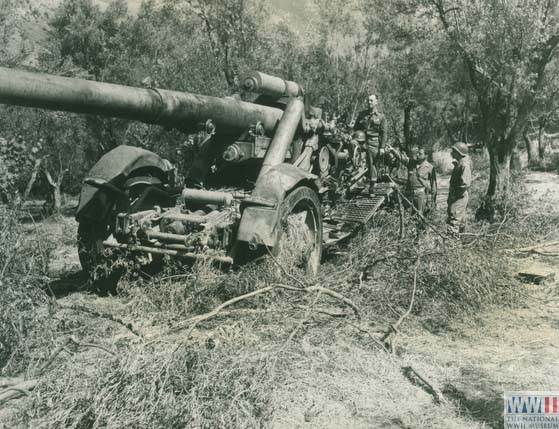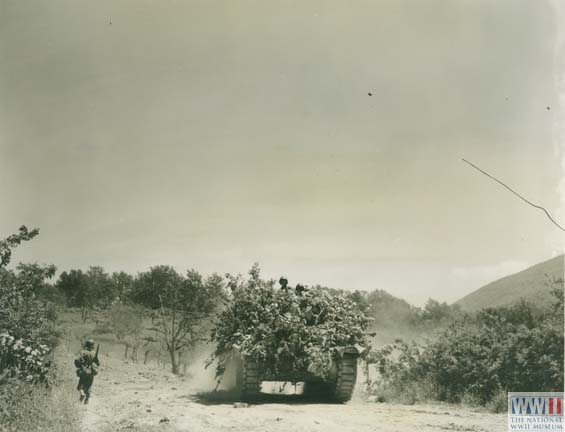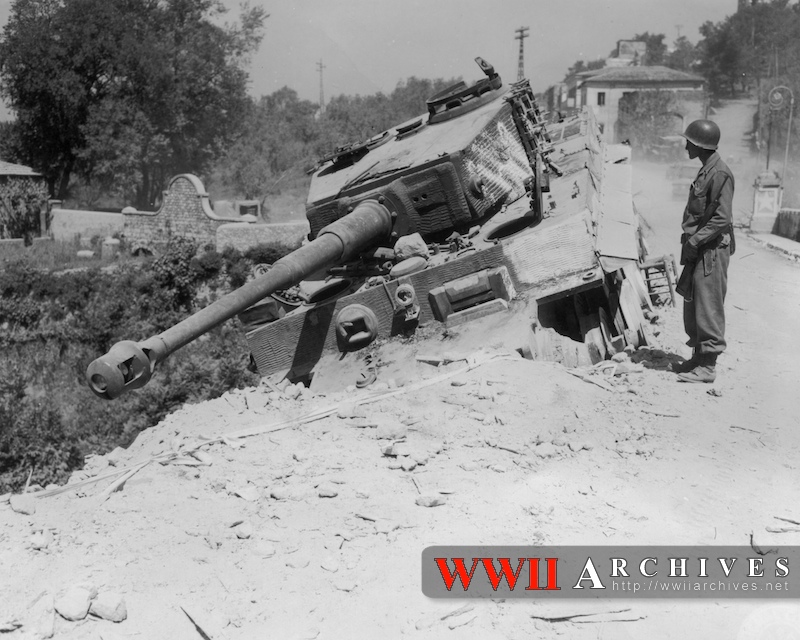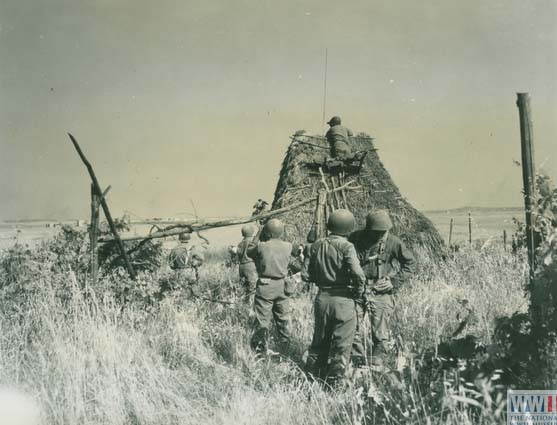Air Operations, CBI
BURMA- 10 7th Heavy Bomb Group B-24s attack Ye-u.
- 12 10th Air Force B-25s attack targets in the Tiddim road.
- B-25s and fighter-bombers complete more than 130 sorties against numerous targets in the Mogaung Valley.
- 21 B-25s and fighter-bombers attack the airfield at Bhamo and Bhamo itself.
- 14 308th Heavy Bomb Group B-24s supported by 14th Air Force P-40s attack warehouses at Lashio.
- 13 308th Heavy Bomb Group B-24s attack Lungling.
- 6 341st Medium Bomb Group B-25s attack Pailochi, and a motor-vehicle convoy at Yoyang.
- 4 B-25s attack the airfield at Hankow.
- 51 P-51s and P-40s attack shipping in the Yangtze River.
- 16 P-51s and P-40s attack Kweiyi, Yoyang, and nearby targets.
- 10 449th Fighter Squadron P-38 fighter-bombers attack a bridge and warehouses at Nanchang.
- 12 P-40 fighter-bombers attack Pingkiang.
- 4 P-40s destroy several aircraft on the ground while strafing the airfields at Hohsien and Linfen.
- 36 10th Air Force A-31s attack the Moraing and Ukhrukl areas.
- 341st Medium Bomb Group B-25s attack a bridge at Kenglaung.
Air Operations, Europe
- Intensive Allied bombing prior to the Normandy invasion resulted in a month's toll of 900 locomotives and 16,000 freight cars destroyed in Nazi-occupied Europe.
- For the first time in nearly 4 years there are no British civilian air raid victims during a monthly reporting period.
- The US 15th Air Force (480 Boeing B-17 Flying Fortresses and Consolidated B-24 Liberators) bombs oil refineries and communications in the Ploesti area; 15 bombers are lost during the raid.
Evening Ops:
- 219 aircraft of all groups except No. 5 Group successfully attack the railway yards at Trappes west of Paris in two waves. Included in this total are 125 Lancasters, 86 Halifaxes and 8 Mosquitos.
- 4 Lancasters are lost.
- 129 aircraft of Nos. 6 and 8 Groups bomb a coastal wireless transmitting station at Au Fèvre and destroy 4 of the 6 masts. In this total are 109 Halifaxes, 16 Lancasters and 4 Mosquitos.
- There are no aircraft losses.
- 115 aircraft including 60 Lancasters, 51 Halifaxes and 4 Mosquitos of Nos. 6 and 8 Groups bomb a radio jamming station at Mont Couple which is 'rendered completely unserviceable'.
- There are no losses.
- 111 Lancasters and 4 Mosquitos of Nos 1 and 8 Groups attack the railway yards at Tergnier. The sidings and workshops are 'squarely hit'.
- 2 Lancasters are lost.
- 82 Lancasters and 4 Mosquitos of No. 5 Group attack and destroy a railway junction at Saumur without a loss.
- 68 Lancasters of No. 5 Group raid a coastal gun battery at Maisy, but the area is cloud-covered and only 6 aircraft drop their bombs without a loss.
- 28 aircraft lay mines off the Dutch and French coasts, 9 aircraft are on Resistance operations, and there are 16 Serrate and 9 Intruder patrols and 14 RCM and 12 OTU sorties.
- 2 Halifaxes and 1 Hudson are lost on Resistance operations along with 1 mine-laying Stirling and 1 Intruder Mosquito.
Railway Bridge at Samur |
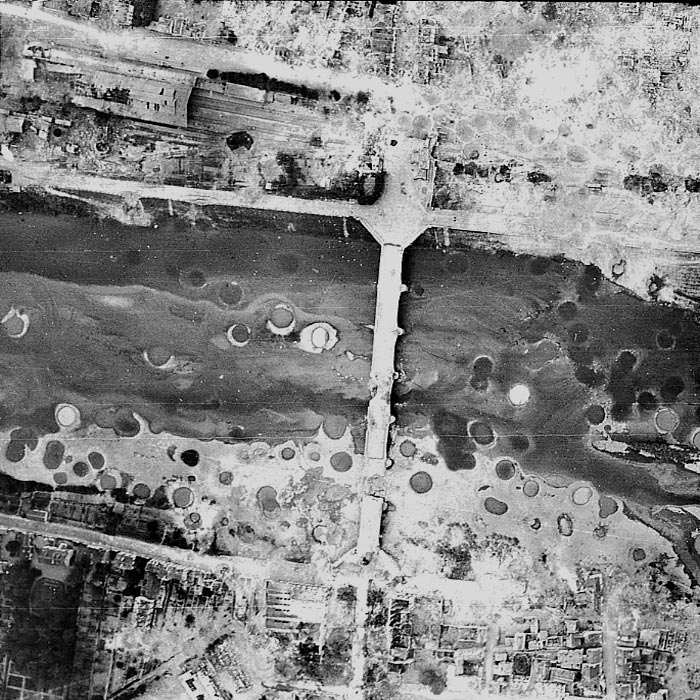 |
BELGIUM:
- Unable to locate their primary target in France because of bad weather, 30 1st Bomb Division B-17s attack the Florennes/Juzaine Airdrome, and 4 B-17s attack a marshalling yard at Namur.
- 36 1st Bomb Division B-17s attack a marshalling yard at Luxeuil.
- 491 of the 495 2nd and 3rd Bomb Division B-24s dispatched to attack rail targets in France and Belgium are recalled due to heavy clouds in the target areas. 4 B-24s attack bridges at Beaumont-sur-Oise and Melun.
- As briefed, 88 3rd Bomb Division B-17s attack the marshalling yard and Osnabruck.
- 54 3rd Bomb Division B-17s attack a marshalling yard at Schwerte.
- After failing to locat their primary targets because of bad weather, 50 3rd Bomb Division B-17s attack a marshalling yard at Hamm.
- 52 B-17s attack a marshalling yard at Oeske.
- Escort for the 8th Air Force heavy bomber missions to France and Germany is provided by 682 VII Fighter Command fighters and 647 IX Fighter Command fighters. The are no Luftwaffe losses.
- 3 VIII Fighter Command fighters and their pilots are lost
- 43 56th Fighter Group P-47s and 35 353rd Fighter Group P-47s attack the Gutersloh Airdrome with 100-pound bombs. 5 Luftwaffe FW-190s are downed over Guersloh about 1915 hours by 56th Fighter Group pilots.
- 35 20th Fighter Group P-38s briefed to attack the Lingen Airdrome get lost and attack the Rheine/Hopstein Airdrome instead, also with 100-pound bombs. 20th Fighter Group claims 5 ground kills.
- Unable to locate their primary target in France because of bad weather, 23 1st Bomb Division B-17s attack the Gilze-Rijen Airdrome.
- 12 1st Bomb Division B-17s attack a marshalling yard.
FRANCE:
- Approximately 200 IX Bomber Command B-26s attack highway bridges at Bennecourt, Courcelles-sur-Seine, and Rouen.
ITALY:
- 12th Air Force B-25s and B26s and XII TAC A-20s and fighter-bombers provide direct support for Allied ground forces in the battle area south of Rome by attacking several defended towns, troop concentrations, and road junctions.
- XII Troop Carrier Command transports continue to evacuate casualties from the Anzio beachhead.
ROMANIA:
- 15th Air Force B-17s and B-24s attack oil facilities at Ploesti.
- 15 heavy bombers are lost
- P-38 and P-51 escort pilots down 21 Axis fighters between 1000 and 1050 hours.
Air Operations, Japan
1 28th Composite Bomb Group B-24 reconnoiters and attacks Buroton Bay.
[Air Operations, New Guinea
- 38th Medium Bomb Group B-25s temporarily based at the Merauke airfield (on the south New Guinea coast) attack the airfields at Babo and Otawiri at minimum level.
- V Bomber Command A-20s attack boats off Japen Island and a landing ground on the Ransiki River.
- 17th Reconnaissance Squadron B-25s and 3rd Light Bomb Group A-20s provide on-call support throughout the day for US Army ground forces on Biak Island.
- B-25s and V Fighter Command P-47s attack barges, artillery positions, and occupied villages in the Wakde Islands and Sarmi area.
- 5th Air Force B-24s and P-39s, and RAAF aircraft attack the area between Hansa Bay and Wewak.
Arctic
U-289 is sunk by the British destroyer HMS Milne.
| Class | Type VIIC |
| CO | Kapitänleutnant Alexander Hellwig |
| Location | Arctic, NE of Jan Mayen Island |
| Cause | Depth charge |
| Casualties | 51 |
| Survivors | None |
CBI
BURMAAir drops of supplies by the 27th Troop Carrier Squadron begin to the Chinese divisions across the Salween River.
By the end of May at least 5,000 Japanese troops are in defensive positions around the town of Myitkyina as the monsoon rains continue. Even though Allied strength reaches 12,000, the Japanese continue to defend tenaciously. The siege of Myitkyina begins and will last until August.
[Eastern Front
The Germans continue their attacks in Rumania, throwing in strong tank, infantry and air forces.
SOVIET COMMANDThe commanders of the BAGRATION fronts receive their orders for the coming offensive.
THE OSTHEERHaving lost the 17th Army in addition to normal wastage, the German armies in the field are reduced by one SS panzer, 1 motorized and 6 infantry divisions, while the Ostheer receives only 2 infantry and 1 of the new Volksgrenadier divisions in return. German strength stands at 21 panzer, 9 panzer grenadier and 134 infantry divisions. Army Group Center loses its LVI Panzer Corps from reserve to Army Group North Ukraine.
[Italy
The Canadians take Frosinone and X Corps takes Sora. The American VI and II Corps receive orders to mount an offensive against the Alban Hills. In the Anzio sector Velletri and Monte Artemino nearby fall to the US 36th Div while other units of VI Corps are attacking round Albano. By the capture of Velletri a gap is torn in the Caesar Line. The 85th Div captures Lariano and reaches positions across the road linking Velletri with Artena.[MORE]
[New Guinea
On Biak, TF HURRICANE continues patrolling and regroups in preparation for renewing its attack. The 1st and 3rd Battalions of the 163rd Infantry arrive.
In the Wadke-Sarmi area, Gen Patrick reduces the defensive perimeter of TF TORNADO to have a greater concentration of fire, but still keep a small bridgehead over the Tor River. In the Hollandia-Aitape area, Company G, 127th Infantry, relieves the Nyaparake Force. The 1st Battalion, 126th Infantry, begins an offensive from the East Sector to drive the enemy back across the Drindarai, advancing against light resistance through Yakamul to Parakovio. The Japanese are becoming aggressive in the sector of the 127th Infantry along the Driniumor and begin crossing the river. To the east Australian troops take Bunabum.
[Pacific
- In Operation KON, which last until June 12, the Japanese dispatch three troop convoys to Biak but only one lands troops.
- The US destroyer escort England (DE-635) along with the destroyers Hazlewood (DD-531) and McCord and the destroyer escorts George (DE-697) and Raby sink the Japanese submarine RO-105 in the Bismarck Sea, northwest of New Ireland. This is the 6th successful attack on submarines by the England (DE-635) in 12 days.
- The Japanese frigate Ishigaki is sunk by the US submarine Herring (SS-233) in the North Pacific area. Herring also sinks the army cargo ship Hokuyo Maru (1590t) west of Matsuwa Island. The US submarine Barb (SS-220), also operating in the Sea of Okhotsk, sinks the army cargo ship Madras Maru (3802t) and the transport Koto Maru (1053t).
Secret War
Agents land on the Ceylon coast from the Japanese submarine I-166.
[Soviet Union, Planning
The Stavka issues its orders for the coming offensive against Army Group Center in Belorussia, codenamed BAGRATION. The Red Army has cleared the Ukraine and lifted the siege of Leningrad, and its advance in the north and south has created a large German salient that bulges into the east. Occupied by Army Group Center, it resembles the Kursk salient of a year previously, although with one difference: it contains weakened German forces that have no reserves upon whih to draw.
On the Eastern Front, the Germans have 1.5 million troops, mostly in understrength and ill-equipped divisions. In addition, the advance of the Red Army to the borders of German's Axis allies, Hungary and Romania, has weakened the resolve of these tow countries to such an extend that German troops not occupy Hungary to prevent its defection. On the opposite side, the Red Army fields 52 armies staffed with 5.5 million men for its offensive. The Stavka is also determined to defeat Finland, and thus the Leningrad and Karelian Fronts have been reinforces. Their combined strength is 450,000 troops, 10,000 artillery pieces, 800 tanks and 1,000 Katyushas, supported by 530 aircraft.
Images from May 31, 1944
|
|
|
|
|
|
